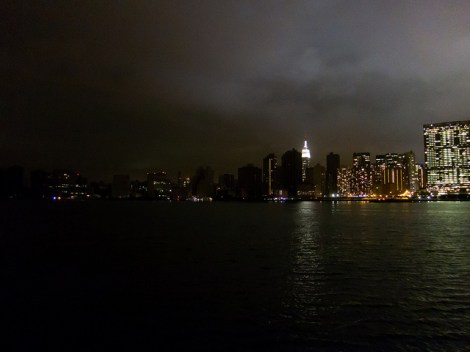The New York transit authority’s success getting the subways back online is probably not appreciated by the region’s power companies, which have had, shall we say, less success.
At midday yesterday, about 700,000 customers were without power, including 200,000 who lost power after winter storm Athena swept through.

TenSafeFrogsManhattan, half-dark after Sandy.
New York Gov. Andrew Cuomo (D), who estimates that Sandy could cost $50 billion in economic damage by the time it’s fully cleaned up, started dropping bombs on the utilities yesterday.
“The progress is unacceptable,” Cuomo said at a press conference. “To say that I am angry, to say that I am frustrated, disappointed, would be the understatement of the decade.”
All of the state’s utilities who have powerless customers, he suggested — Con Ed, the Long Island Power Authority, the New York State Electric and Gas Corporation (NYSEG), and Orange & Rockland — could be in for a rude awakening after cleanup is over.
“I promise the people of this state that they will be held accountable for their lack of performance,” he added. “These are not God-given monopolies. I will review all of them.”
Part of the lack of progress is due to some utilities, like Long Island Power Authority, being woefully unprepared for the scale of Sandy. From Newsday:
The Long Island Power Authority’s agonizingly slow response to Sandy came after warnings as far back as 2006 that the utility was unprepared to handle a major storm, failed to upgrade antiquated technology, neglected vital maintenance and regularly underbudgeted for storm response.
A state report and a review of records show that the regional utility lagged behind industry standards by not using smartphones and digital tablets — and at times even printers or fax machines — in favor of pen-and-paper memos and dial-up Internet access. …
LIPA neglected basic maintenance to prevent outages, such as replacing rotting poles and trimming trees around power lines, according to a state report released by the Public Service Commission’s Public Service Department in June. The $3.7 billion-a-year government-owned corporation spent $37.5 million less than committed over five years on hardening the grid to protect against major storm damage, according to the report.
Customers of LIPA and other unresponsive utilities may have legal recourse, according to Reuters.
According to [attorney Scott] Kreppein, there’s nothing barring customers — whether they’re businesses or individual ratepayers — from bringing such suits against power companies, even though utilities are state-regulated. To win, however, New York ratepayers have to show that their power company was not just slow or inefficient. Instead, Kreppein said, under a 1985 New York Court of Appeals ruling called Strauss v. Belle Realty, electric company customers must establish that the utility was grossly negligent — that its conduct was way outside the bounds of reasonableness.
Kreppein’s home is itself without power. He is a LIPA customer. Hopefully someone printed out that Reuters column and mailed it to LIPA’s attorneys.




